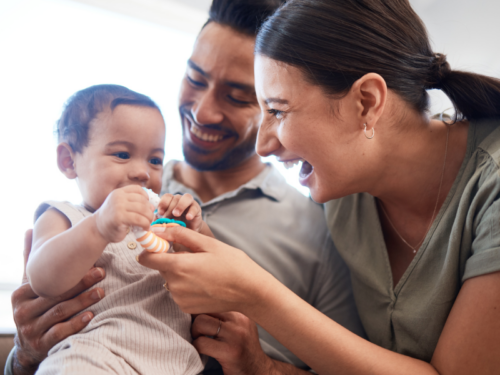
Table of Contents
Postpartum OCD 101: Signs, Differentiation & Treatment

Written By: Sarah duRivage-Jacobs

Clinically Reviewed By: Dr. Don Gasparini
August 29, 2023
7 min.
Up to about one-quarter of the postpartum population may experience postpartum OCD. Here’s how to differentiate postpartum OCD symptoms from other perinatal mood and anxiety disorders.
Learn more about our Clinical Review Process
Table of Contents
Being pregnant and giving birth are transformative experiences for the mind and body. Because of this, mental health changes are common after having a baby. For up to 80% of people in the postpartum period, the first few days after giving birth are marked by a sadness commonly called “baby blues.” For up to 20%, depressive and anxiety symptoms are more significant. This article focuses on one particular anxiety disorder that can be exacerbated in the postpartum period: postpartum obsessive-compulsive disorder (OCD).
Here, we’re explaining what pregnant and postpartum people should know about postpartum OCD, how the condition differs from others, and what treatment options people dealing with OCD symptoms can consider as they manage the joys and complexities of new parenthood.
What is postpartum obsessive-compulsive disorder (OCD)?
Postpartum OCD is OCD diagnosed in the postpartum period, typically defined as the first 12 months after a baby is born. OCD is an anxiety disorder marked by intrusive thoughts or images (obsessions) and mental or physical rituals (compulsions) that ease the distress brought on by the intrusive thoughts. Postpartum OCD is often misunderstood and misdiagnosed, especially since obsessive thoughts of harming an infant—a common feature of postpartum OCD—can be misinterpreted as signs of postpartum psychosis, a more severe and rare condition.
If you’ve had unwanted and distressing thoughts or urges frequently enter your mind and you’ve felt the need to do certain mental or physical activities to stop them, then learning more about postpartum OCD may be helpful. (If you’re having thoughts of harming yourself or someone else, including an infant, this is a mental health emergency, and you should contact The Suicide & Crisis Lifeline by calling or texting 988.)
A 2015 review published in Women’s Health shared a case study of someone with postpartum OCD. The 27-year-old in the case study had previously been treated for OCD before stopping her medication in pregnancy. She had obsessive thoughts about her father harming her newborn despite no evidence that was happening. Weeks later, the obsessions intensified to the point that she reported her father to child protection services. The investigation concluded that the woman’s allegations against her father were false.
Signs of postpartum OCD
The signs of postpartum OCD are the same as OCD at any time. The difference is that postpartum OCD occurs after pregnancy. Often, the obsessions are around intentionally or accidentally harming the new baby, and the compulsions involve checking behaviors (like repeated checking of a sleeping baby) and avoiding objects or circumstances that may harm the baby. The intrusive thoughts or images may be very graphic, and they cause immense suffering for the person who experiences them. The graphic nature of these thoughts and images often make it harder for people to disclose what they’re going through with a healthcare provider.

Being a new parent can be isolating.
Our virtual intensive therapy program has flexible scheduling so you can connect with people who get it.
How is postpartum OCD diagnosed?
The diagnostic criteria for postpartum OCD, like OCD at any time of onset, include the presence of both obsessions and compulsions—defined respectively as recurrent distressing and unwanted thoughts that people may try to suppress by repetitive mental or physical acts.
For someone to be diagnosed with postpartum OCD, their obsessions or compulsions must take up more than one hour a day, cause significant distress, or impair their social life, work-life, or other areas of daily function. Also, to meet the diagnostic criteria for postpartum OCD, obsessions and compulsions can’t be related to the effects of a substance, medication, medical condition, or another mental health condition.
How is postpartum OCD different from other postpartum mental health conditions?
Postpartum OCD vs. expected anxieties
Postpartum OCD vs. generalized anxiety disorder (GAD)
Postpartum OCD vs. postpartum depression
Postpartum OCD vs. postpartum psychosis
Expected postpartum anxieties don’t interfere with someone’s daily functioning and don’t cause extreme distress, whereas postpartum OCD does.
GAD is marked by worries related to various parts of life, whereas postpartum OCD symptoms are typically only related to the baby and its care.
Postpartum depression symptoms are connected to mood, whereas postpartum OCD symptoms come up regardless of mood.
Postpartum psychosis results in higher rates of harming an infant or oneself, whereas postpartum OCD typically just includes illogical thoughts and compulsions related to infant harm.
Because of some overlap in postpartum symptoms, a general lack of awareness of many healthcare providers about postpartum OCD, and shame surrounding thoughts of infant harm, it’s critical for postpartum people and clinicians to know the differences between postpartum OCD and other postpartum mental health conditions. Here’s an overview of postpartum OCD compared to other mental health conditions that people may experience after giving birth.
Postpartum OCD versus expected anxieties
About 34 to 65% of postpartum people have anxious thoughts that are considered “normal” for new parents. These thoughts are typically temporary, don’t interfere with someone’s daily functioning, and don’t cause extreme distress. They may even be beneficial for protecting a new baby from being hurt.
Postpartum OCD versus generalized anxiety disorder (GAD)
Generalized anxiety disorder (GAD) is another anxiety disorder marked by issues with regulating worries brought on by different events and circumstances. A distinguishing feature of postpartum OCD is that the OCD symptoms are rarely related to daily functions outside of childcare.
Postpartum OCD versus postpartum depression
Over 57% of postpartum people experiencing postpartum depression may have obsessive thoughts about infant harm. However, for people with postpartum OCD, the symptoms come up regardless of mood, are intrusive, and cause extreme distress. Because someone may experience both postpartum depression and postpartum OCD, it’s important for mental health providers to use screening tools to better understand an individual’s symptoms.
Postpartum OCD versus postpartum psychosis
Postpartum psychosis is a rare condition (1 to 2 out of every 1,000 births) marked by delusions, hallucinations, and paranoid thoughts.
People with postpartum OCD typically do not actually harm their infants, and they’re aware that their thoughts and compulsions aren’t based on logic. However, among people with postpartum psychosis, there are significantly higher rates of harming the infant or themselves. For these reasons, postpartum psychosis is a psychiatric emergency, and, as mentioned, people should immediately contact emergency mental healthcare. Of note, people with postpartum OCD may inadvertently harm their infants through avoidant behaviors and their impact on the developing parent-child bond.
People with postpartum psychosis may have other symptoms like hyperactivity, a reduced need for sleep, constant jumping between ideas, and reckless behavior. Postpartum psychosis may also be related to bipolar disorder.
How common is postpartum OCD?
Different studies have published different prevalence rates for postpartum OCD. Between 2 and 24% of the postpartum population may experience postpartum OCD. However, among those with existing OCD, pregnancy and the postpartum period may exacerbate symptoms for 8-70%.

Why do some people have OCD symptoms after giving birth?
Experts are still learning about the possible causes of OCD during and after pregnancy. But there’s clear evidence that it’s a combination of psychosocial as well as biological factors.
Preliminary research has identified the following factors as possible contributors to OCD onset in or after pregnancy:
- Birth complications
- Personal or family history of mood disorders
- Existing obsessive beliefs
- Avoidant personality
- Obsessive-compulsive personality
- First-time birth and parenting
- Lack of sleep
- Genetic biomarkers (in the genetic makeup) and epigenetic biomarkers (changes due to environment and behaviors)
- Immune system changes in pregnancy
- Hormonal changes in pregnancy
- Dysregulation in the neurotransmitter (chemical signals from the body’s nerve cells)
Do you need more support with
your mental health?
Charlie Health can help.
How is postpartum OCD treated?
Every individual experiencing postpartum OCD can work with professionals to compare the risks and benefits of different treatment options versus no treatment. While there isn’t much research investigating the effects of untreated postpartum OCD specifically, perinatal mood and anxiety disorders can lead to adverse outcomes for the parent and the baby.
Cognitive behavioral therapy (CBT)
Cognitive behavioral therapy (CBT) is the only evidence-based therapy for treating people with OCD. In CBT, people can develop skills and learn tools to identify and change distressing thought patterns and behaviors.
CBT with a focus on exposure and response prevention (ERP) is considered the first-line treatment for OCD. ERP involves the practice of facing obsessive thoughts head-on and choosing not to engage in the compulsions that typically follow.
While there haven’t been randomized-controlled trials (the “gold standard” of clinical research) exploring CBT with ERP for postpartum people, observational studies—that is, ones that don’t compare treatments but instead observe their effects in the real world—show improvement in symptoms.
Some postpartum OCD symptoms may also be helped by other therapeutic modalities, including family therapy, motivational interviewing, and dialectical behavior therapy (DBT). However, CBT with ERP is the only treatment shown to work without taking medication.
Medication
There are no treatment guidelines for postpartum OCD. That said, the Federal Drug Administration (FDA) has approved several selective serotonin reuptake inhibitors (SSRIs)—fluoxetine, fluvoxamine, and paroxetine—as well as the antidepressant clomipramine for OCD. All of these medications are considered safe during and after pregnancy.
OCD treatment at Charlie Health
If you’re struggling with obsessions and compulsions after birth or have been diagnosed with postpartum OCD, Charlie Health is here to help. Charlie Health’s virtual Intensive Outpatient Program (IOP) blends therapeutic modalities to provide clients with the personalized care they need to better manage their symptoms—including postpartum OCD symptoms.
Clinicians at Charlie Health are experts in the best therapeutic treatments for OCD, including CBT, motivational interviewing, and DBT skills. After getting to know a client’s needs and preferences, they’re matched with clinicians for individual therapy and family therapy, as well as peers facing similar challenges in supported group sessions.
Because our IOP is 100% virtual, you can get intensive treatment for your symptoms without spending time away from your new baby or cutting back on childcare duties. Getting support without leaving home and your baby also means you’ll be able to practice your new skills in the context of your daily life.
Fill out this short form today to learn more about our IOP and find out if it’s right for you. We’re standing by 24/7, 365 days a year, to get you started.




